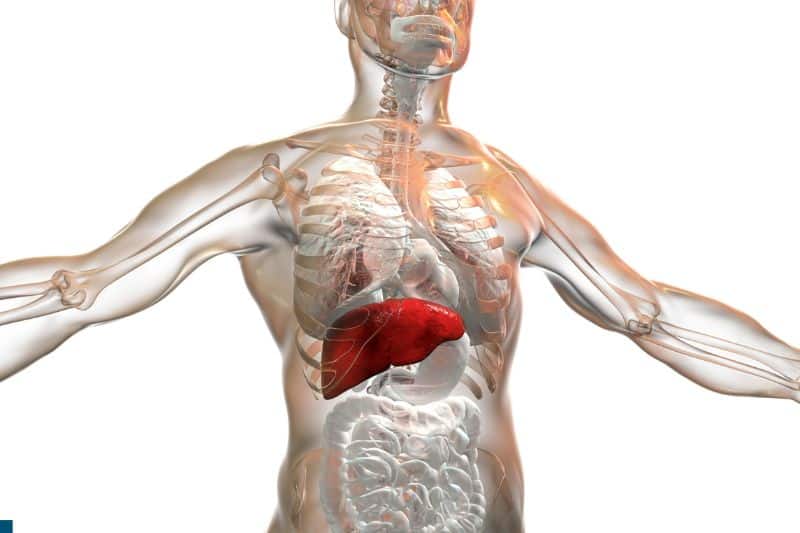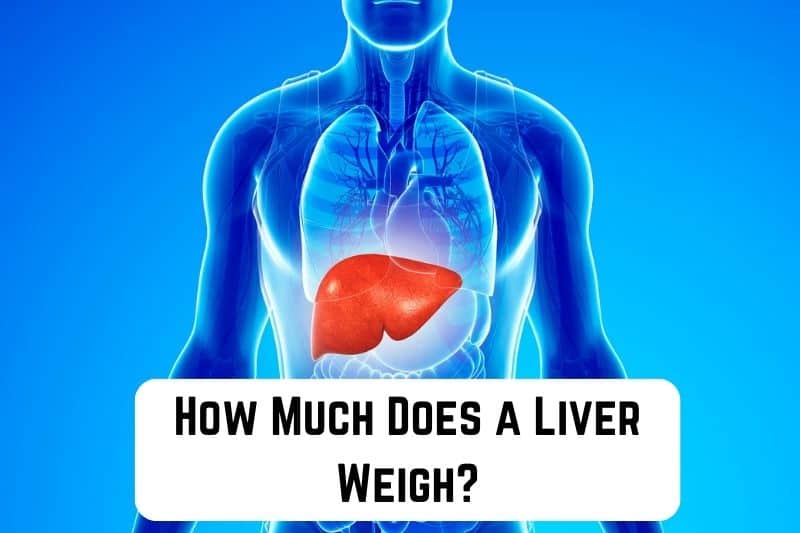When you think about the human body, you might not immediately consider the weight of your organs. However, understanding the weight of vital organs like the liver can offer insight into overall health and functioning. This article will discuss how much a liver typically weighs and the factors that can influence this weight.
The liver is a remarkable organ that plays a crucial role in your body’s essential functions, including digestion, metabolism, detoxification, and blood clotting.
It is the largest internal organ in your body and is situated beneath your diaphragm on the right side of the upper abdominal cavity. The weight of a healthy liver can vary depending on factors such as age, sex, and body size.
Generally, an adult’s liver weighs approximately 1.2 to 1.6 kilograms (2.5 to 3.5 pounds). Factors that can cause variations in liver weight include medical conditions, lifestyle choices, and individual genetics. Stay tuned as we explore these factors and how they might affect your liver’s weight.
Read: How Much Does a Stomach Weigh? (Quick Answer)
On average, the liver of a male adult weighs around 1.5 kilograms (3.3 pounds), while the liver of a female adult weighs approximately 1.2 kilograms (2.6 pounds). This difference in weight can be attributed to the varying levels of hormones, body mass, and genetic factors between the sexes.
Measuringly.com
Human Liver Basics
Anatomy of the Liver
Your liver is a large, reddish-brown organ located in the upper right side of the abdomen. It has a unique lobed structure, divided into two main lobes (right and left), further subdivided into smaller lobules. The liver is surrounded by a thin capsule known as Glisson’s capsule. It receives blood from two main sources – the hepatic artery and the portal vein.
Some key components of your liver include:
- Hepatocytes: These are the primary cells in the liver that carry out most of its functions.
- Bile ducts: These small tubes transport bile produced in the liver to other parts of the digestive system.
- Portal triad: This structure consists of a bile duct, a portal vein branch, and a hepatic artery branch, which help supply blood and bile to/from the liver.
Functions of the Liver
The liver serves many essential functions in your body. Here are a few key roles:
- Bile production: Your liver produces bile, a yellowish-green fluid that aids in digestion by breaking down fats and eliminating waste products.
- Metabolism: It plays a crucial part in metabolizing nutrients, such as carbohydrates, proteins, and fats, to generate energy and synthesis of key molecules.
- Detoxification: The liver filters out harmful substances such as drugs, alcohol, and other toxins, either transforming them into safer compounds or expelling them from your body.
- Storage: Your liver stores essential nutrients like vitamins and minerals, glycogen (the storage form of glucose), and fats to be released when needed.
- Blood clotting factors: It produces proteins necessary for blood clotting, preventing excessive bleeding during injury or surgery.
These functions, among others, make the liver an essential organ for maintaining your overall health.
Understanding Liver Weight
Your liver is an essential organ that performs numerous functions for your body. Knowing the average liver weight and the factors that influence it can provide a better understanding of its role in your overall health.
Average Human Liver Weight
The weight of a liver can vary between individuals, but on average, a healthy adult liver weighs about 1.4 to 1.6 kg (3.1 to 3.5 pounds). For simplicity, you may consider the approximate average liver weight to be:
- 1.5 kg (3.3 pounds) for adult men
- 1.2 kg (2.6 pounds) for adult women
By understanding these figures, you can have a general idea about the size and weight of a typical human liver.
Factors Influencing Liver Weight
Several factors can influence liver weight. Some of the most common ones include:
- Age: As you age, your liver may decrease in size and weight.
- Gender: Men tend to have larger, heavier livers than women. This is partly due to differences in body size and composition.
- Body Weight: Individuals with higher body weights usually have larger and heavier livers. This correlation between liver size and body weight can help healthcare providers determine if your liver is within a healthy range for your body.
- Health Conditions: Certain health conditions can impact liver weight. For example, fatty liver disease can cause an increase in liver size and weight due to the accumulation of fat. On the other hand, liver cirrhosis can reduce liver size and weight due to scarring and loss of functional liver tissue.
It’s important to remember that your liver’s weight alone is not the sole indicator of its health. Discussing your liver health with a medical professional will provide a more comprehensive understanding of its condition.

Medical Importance of Liver Weight
Liver Weight in Disease Diagnosis
Your liver plays a crucial role in maintaining your overall health. It participates in digestion, detoxification, and metabolism processes. Thus, knowing your liver’s weight can be essential in diagnosing certain liver conditions.
For instance, a significant increase in liver weight might indicate liver diseases such as hepatomegaly (enlarged liver), cirrhosis, or fatty liver disease. On the other hand, a decrease in liver weight could suggest conditions like liver atrophy.
To determine your liver weight, doctors usually rely on imaging techniques, like ultrasound and computed tomography (CT) scans, enabling them to make an accurate diagnosis and appropriate treatment plan.
Liver Weight and Transplants
In liver transplant cases, the donor’s and the recipient’s liver weight are essential to ensure a successful procedure. The donor liver must be of appropriate size, weight, and function for transplantation.
The medical professionals will closely examine the liver size to ensure a good match between donor and recipient. Ideally, the graft-to-recipient weight ratio (GRWR) should be between 0.8% and 3% for optimal transplant outcomes.
This measurement helps ensure that the transplanted liver provides adequate function in the recipient’s body while reducing the risk of complications.
Moreover, during the transplant procedure, surgeons carefully weigh the donor’s liver to ensure it fits within the recipient’s body safely and effectively. This information further allows for accurate surgical planning and better post-transplant recovery support.
Differences in Liver Weight
When considering liver weight, it’s important to know that it can vary depending on sex and age. In this section, you’ll learn about the differences in liver weight between females and males, as well as adults and children.
Liver Weight in Females vs Males
It’s no surprise that liver weight differs between females and males. On average, the liver of a male adult weighs around 1.5 kilograms (3.3 pounds), while the liver of a female adult weighs approximately 1.2 kilograms (2.6 pounds).
This difference in weight can be attributed to the varying levels of hormones, body mass, and genetic factors between the sexes.
Here are some average liver weights:
- Male adults: 1.5 kg (3.3 lbs)
- Female adults: 1.2 kg (2.6 lbs)
Liver Weight in Adults vs Children
As you might have guessed, the liver weight of children is much lower than that of adults, mainly due to their smaller body size. The liver grows with the child, reaching its adult weight as the child matures.
In newborns, the liver weighs about 0.15 kg (0.33 lbs) and will grow to roughly 0.45 kg (1 lb) by their first birthday. By age 10, a child’s liver will have reached approximately 50% of its fully-grown adult weight.
To give you an idea, below is a table of liver weights in different age ranges:
| Age | Liver Weight |
|---|---|
| Newborn | 0.15 kg (0.33 lbs) |
| 1 year | 0.45 kg (1 lb) |
| 10 years | ~50% of adult liver weight |
Comparing Liver Weight to Other Organs
Your liver is one of the largest organs in your body, and you might be curious about how its weight compares to other organs. A healthy adult liver weighs approximately 1.4 to 1.6 kilograms (3 to 3.5 pounds). This weight varies among individuals based on age, gender, and overall health.
To give you a better sense of how the liver’s weight stacks up against other organs, let’s compare it to a few examples:
- The heart, which is crucial in pumping blood throughout your body, typically weighs between 280 to 340 grams (0.6 to 0.7 pounds). That means your liver is roughly four to five times heavier than your heart.
- Your lungs play an essential role in respiration; they weigh about 1 to 1.2 kilograms (2.2 to 2.6 pounds). This makes them slightly lighter than the liver.
- The brain, responsible for controlling your body’s functions and processing information, weighs approximately 1.3 to 1.4 kilograms (2.9 to 3.1 pounds), making it quite similar in weight to the liver.
Read: How Much Does the Spleen Weigh? (Answered)
Here’s a quick summary in the form of a table for easy reference:
| Organ | Weight |
|---|---|
| Liver | 1.4 – 1.6 kg (3 – 3.5 pounds) |
| Heart | 280 – 340 g (0.6 – 0.7 pounds) |
| Lungs (pair) | 1 – 1.2 kg (2.2 – 2.6 pounds) |
| Brain | 1.3 – 1.4 kg (2.9 – 3.1 pounds) |
While it’s fascinating to compare the liver’s weight to that of other organs, it’s important to remember that each organ in your body serves a unique and vital function. However, their size and weight are not necessarily the best indicators of their importance to your overall health. So, make sure to take good care of your body as a whole to maintain a healthy balance.







